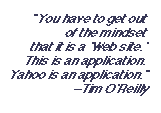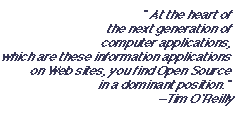|Feedback To Author | Feedback
To Webmaster
Copyright © 1999 by Michael Robin. All Rights Reserved.
Open Source Software: More Than An Emerging Alternative
By Michael Robin
Tim O'Reilly on Open Source technology and the next killer
app
 During the past
year, the Open Source software movement has been gaining momentum.
In the wake of the US Department of Justice's antitrust lawsuit
against Microsoft, much of the attention to Open Source software
has been focused on the Linux operating system as a potential
alternative, or threat, to Microsoft Windows NT. But in practice,
Open Source refers to a much broader range of software, easily
describing much of the software that has been instrumental in
building the Internet.
During the past
year, the Open Source software movement has been gaining momentum.
In the wake of the US Department of Justice's antitrust lawsuit
against Microsoft, much of the attention to Open Source software
has been focused on the Linux operating system as a potential
alternative, or threat, to Microsoft Windows NT. But in practice,
Open Source refers to a much broader range of software, easily
describing much of the software that has been instrumental in
building the Internet.
Although the term Open Source was only coined in February 1998,
Tim O'Reilly and his company, O'Reilly
&Associates, have been involved with Open Source software
for many years. From its beginning in the late 1970s, O'Reilly
& Associates has written and published manuals for much of
the software commonly referred to as Open Source. Today, they
publish more than 120 titles and have offices in the US, UK, France,
Germany, Japan, Taiwan, and China.
I recently spoke with Tim O'Reilly, founder and CEO of O'Reilly
& Associates, about why Open Source software is important.
Open Source has become a hot topic these days. Why?
I think there are two Open Source stories. One is the story
of Linux emerging as a possible alternative to Microsoft, particularly
in the server space. That's an interesting story, but that is
not the Open Source story I find most interesting.
What I think most people haven't realized is that Open Source
has already completely changed the face of the computer industry.
And where it has done it is on the Internet.
The best way I can get this across is to tell a story of some
friends who did not own a computer. They were looking to buy a
computer so they could use Amazon. That's a classic definition
of a killer application: here is something that people are going
to buy a computer to use. They are not getting a computer to use
the Internet. They are getting a computer to use Amazon! For them,
Amazon is the application, and they may eventually use some other
parts of the Web.
To me, this says there is a fundamental shift in why people
are using computers. For a long time  computer
use was driven by desktop productivity applications. Now we have
this new kind of application. You have to get out of the mindset
that it is a "Web site." No, this is an application
Yahoo is an application.
computer
use was driven by desktop productivity applications. Now we have
this new kind of application. You have to get out of the mindset
that it is a "Web site." No, this is an application
Yahoo is an application.
Explain this a little more. What do you mean by "this
is an application"?
A lot of these Web sites are actually different ways of computerizing
things that were difficult to computerize in the past. A really
good example is maps.yahoo.com.
Type in two addresses and you get back a map and a set of directions.
That's pretty cool. That is a classic information application,
not something you would have been able to do even a few years
ago. There are probably hundreds, even thousands, of different
kinds of information applications that the Web is enabling that
are going to transform the computer industry.
What does all that have to do with Open Source?
If you look at the Internet, and the Web in particular, it
is dominated by Open Source technologies--absolutely dominated.
The clearest example of that is Yahoo. Here is the world's largest
Web site; it runs almost entirely on Open Source. What's the operating
system? FreeBSD. What's the Web server? Apache. What's the mechanism
they use to make all that interesting, dynamic content? Oh, it's
Perl. The same thing at Amazon. Amazon is built with Perl. A lot
of what happens there is Perl talking to back-end software datab
ases.
The fact that this is Open Source is not necessarily critical
to the fact that they are being used in these applications. It
would certainly be possible for proprietary vendors to try to
emulate what's happening. Microsoft is in fact doing that. They
are basically pushing IS (Internet Server) to take market share
from the free Web servers. They are also trying to push Visual
Basic Script to try to compete with Perl. They tried and failed
miserably with ActiveX, to try to make it compete with the kind
of things that were happening with CGI and Perl. The point is,
it is not intrinsically Open Source, but it is in fact Open Source
that is at the heart of all these interesting new things.
What I am saying is, at the heart of the next generation of
computer applications, which are these information applications
on Web sites, what you find is Open Source in a dominant position.
To me the biggest impact of Open Source is not in the world
of desktop applications. It is what kind of things Open Source
technologies are making available in the way of these Web-based
information applications.
What is Open Source?
Open Source as a catch phrase is pointing to technologies that
are put out under a license that allows them to be freely distributed
and requires source code to be available. In practice, that describes
a lot of the original Internet software. A lot of the infrastructure
that makes the Internet run is Open Source, such as Bind, the
program that runs the DNS [Domain Name Server] that lets you type
www.oreilly.com instead
of 207.25.194.6. Similarly, when you send email messages over
the Internet, chances are pretty good they are handled by a Sendmail
server, which again is Open Source. For that matter, even AOL
uses Sendmail as their mail engine. It is not the user interface,
but it is the thing that actually figures out where to send the
mail.

What is special about Open Source that makes it the enabling
technology for so much of this new activity?
If you look at these next generation applications, I think
there are some ways that the Open Source movement is particularly
appropriate for building specialized applications.
A lot of why Perl, for example, was so important to the Web
was that it's accessible to non-programmers to a greater degree
than languages like C or Java. Larry Wall, the creator of Perl,
has a slogan he uses sometimes. He says, "Perl makes easy
thing easy and hard things possible." A lot of languages
either make easy things easy and hard things impossible or they
make both easy things and hard things difficult.
With the Web, you had people who weren't programmers, who all
of a sudden were building applications. Usually when you get people
who aren't professionals in a field, they basically re-invent
it. The low barriers to entry that Open Source software creates
are a key driver of innovation in the computer industry right
now. It is letting new people into the market.
The last real explosion in the computer industry was when hardware
became cheap and commoditized by the PC revolution. That meant
you didn't have to be at IBM anymore [to be in the computer business].
You could be this little company up in Redmond, or Lotus, a little
company in Massachusetts. They became big players.
Then Microsoft eventually got into the catbird seat and started
raising barriers to entry to the market, making it difficult for
new software players to enter. We then had the Open Source movement,
which said "OK, we can't compete commercially but let's just
give this stuff away." Again, this lowered the barrier to
entry; we got new players into the market and it created the kind
of ground where people like Yang and Filo [from Yahoo] and Jeff
Bezos [from Amazon] could build new businesses. They largely did
it using those free tools.
If you look back at the Microsoft vision with the Microsoft
Network, you had to pay pretty heavy-duty fees to be part of their
Network. Anyone can play, just pony up $30,000. By contrast, when
you look at the Internet, anybody could play by going out and
downloading some free software. That led to this explosion of
new applications.
Is there a single message about Open Source that you believe
people need to hear?
The biggest message I would say is that Open Source is not
a fringe thing. You can, for example, use Linux with confidence.
You can use Perl with confidence. These technologies have been
used to build some of the most interesting and dynamic things
that are happening in the computer industry.
Perception and the reality were pretty far apart for awhile--it
was sort of like "Microsoft is where the action is and this
Open Source thing is just for these hacker freaks." In fact,
the fringe hacker freaks went and built the stuff that now Microsoft
is trying to imitate. Paying attention to what happens in the
Open Source community is a really good way to be ahead of the
curve.

 During the past
year, the Open Source software movement has been gaining momentum.
In the wake of the US Department of Justice's antitrust lawsuit
against Microsoft, much of the attention to Open Source software
has been focused on the Linux operating system as a potential
alternative, or threat, to Microsoft Windows NT. But in practice,
Open Source refers to a much broader range of software, easily
describing much of the software that has been instrumental in
building the Internet.
During the past
year, the Open Source software movement has been gaining momentum.
In the wake of the US Department of Justice's antitrust lawsuit
against Microsoft, much of the attention to Open Source software
has been focused on the Linux operating system as a potential
alternative, or threat, to Microsoft Windows NT. But in practice,
Open Source refers to a much broader range of software, easily
describing much of the software that has been instrumental in
building the Internet. computer
use was driven by desktop productivity applications. Now we have
this new kind of application. You have to get out of the mindset
that it is a "Web site." No, this is an application
Yahoo is an application.
computer
use was driven by desktop productivity applications. Now we have
this new kind of application. You have to get out of the mindset
that it is a "Web site." No, this is an application
Yahoo is an application.